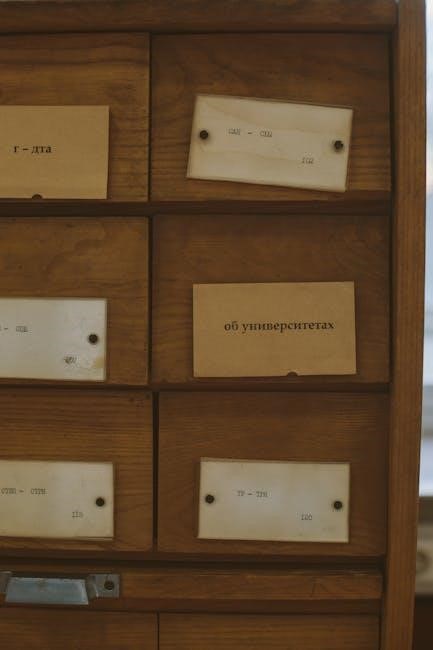The Princeton Guide to Historical Research offers a comprehensive approach to historical inquiry, blending traditional methodologies with digital tools․ It equips researchers with essential skills to explore the past, emphasizing critical thinking, evidence-based analysis, and compelling storytelling․ This guide is tailored for students, scholars, and professionals seeking to master the historian’s craft in the modern era․
What is Historical Research?
Historical research is a systematic investigation into the past, exploring events, people, and cultures through diverse sources․ It involves analyzing primary sources, such as documents and artifacts, and secondary sources, like scholarly interpretations․ The Princeton Guide emphasizes that historical research is both a science and an art, requiring critical analysis and interpretative skills․ Researchers must evaluate evidence, contextualize findings, and construct coherent narratives․ This process helps uncover patterns, understand causes, and interpret historical phenomena․ By bridging the past and present, historical research fosters a deeper understanding of human experiences and societal development, making it a cornerstone of academic and intellectual inquiry․
The Importance of Historical Research
Historical research is vital for understanding the past, informing the present, and shaping the future․ It provides insights into societal development, cultural evolution, and human experiences․ By studying historical events, researchers can identify patterns, understand the roots of contemporary issues, and learn from past successes and failures․ The Princeton Guide highlights that historical research fosters critical thinking, problem-solving, and empathy․ It also promotes a deeper appreciation for diversity and complexity in human societies․ Moreover, historical inquiry encourages the preservation of heritage and the development of informed decision-making․ Ultimately, it serves as a foundation for addressing global challenges and fostering progress․
Key Skills for Historical Research
Mastering historical research requires a combination of critical thinking, analytical skills, and attention to detail․ The ability to formulate clear research questions and interpret complex sources is essential․ Researchers must also cultivate effective search strategies, using Boolean operators and advanced techniques to locate relevant materials; Organizational skills are crucial for managing and synthesizing large amounts of information․ Additionally, historians need to evaluate sources for credibility and bias, ensuring the accuracy of their interpretations․ Proficiency in using digital tools, such as citation management software, further enhances the research process; These skills collectively enable historians to produce rigorous, well-supported, and engaging scholarship․

Building a Research Question
Building a research question involves starting with broad inquiries and narrowing them down to specific, focused issues․ The Princeton Guide helps scholars refine their questions effectively․
How to Formulate a Research Question
Formulating a research question begins with identifying a broad topic of interest and narrowing it down to a specific issue․ The Princeton Guide suggests starting by brainstorming keywords and refining them into focused inquiries․ Researchers should consider gaps in existing literature and frame questions that address these gaps․ It’s important to ensure the question is clear, concise, and executable within the scope of available sources․ The guide also recommends using Boolean operators to refine searches and exploring tools like search statement generators․ By following these steps, historians can craft meaningful questions that guide their research effectively and yield significant insights․
Examples of Effective Research Questions
Effective research questions are clear, focused, and grounded in evidence․ For instance, “How did the introduction of the railroad in the 19th century impact local economies in the American West?” is a strong question because it is specific and measurable․ Another example, “What role did gender play in shaping public responses to the 1918 influenza pandemic?” effectively narrows the scope while addressing a significant historical issue․ The Princeton Guide emphasizes that questions should be open-ended, allowing for nuanced exploration, while remaining tied to identifiable sources․ Such questions guide researchers to uncover meaningful patterns and connections, ensuring their work contributes to historical understanding․
Refining Your Research Question
Refining your research question is a crucial step in historical research, as outlined in the Princeton Guide․ It involves narrowing your focus to ensure clarity and feasibility․ Start by identifying the core issue and assessing the availability of relevant sources․ Tools like timelines and concept maps can help visualize relationships between ideas․ Ask whether your question is specific enough to be answered within the scope of your project․ Revise your question based on preliminary findings, ensuring it remains open-ended yet focused․ This iterative process ensures your question is both meaningful and manageable, guiding your research toward a significant contribution to historical understanding․

Effective Search Queries
Effective search queries combine clarity, specificity, and Boolean operators to refine results․ Use tools like thesaurus and advanced search features to locate relevant historical data efficiently․
Understanding Search Query Syntax
Understanding search query syntax is crucial for effective historical research․ It involves using specific structures and operators to refine searches․ Boolean operators like AND, OR, and NOT help narrow or broaden results․ Quotation marks can search for exact phrases, while truncation (*) retrieves variations of words․ Advanced techniques include using site: or filetype: to target specific domains or document types․ These strategies enhance precision, ensuring relevant historical sources are identified efficiently․ Mastering syntax saves time and improves the quality of research outcomes, especially when exploring vast digital archives or databases with historical content․ This skill is essential for historians navigating complex datasets in the digital age․
Using Boolean Operators
Boolean operators are essential tools for refining historical research searches․ The AND operator combines terms to narrow results, ensuring both concepts are present․ OR broadens searches by including synonyms or related terms․ NOT excludes irrelevant terms, helping to focus on specific topics․ For example, searching “education OR schooling” retrieves results using either term, while “historical research AND methodology” narrows results to relevant sources․ Advanced techniques include combining operators, such as “19th century AND (agriculture OR farming)․” These strategies enable researchers to efficiently locate precise historical data, enhancing the accuracy and depth of their studies․ Mastering Boolean logic is vital for effective historical research in digital databases and archives․
Advanced Search Techniques
Advanced search techniques enhance the precision of historical research by leveraging sophisticated query strategies․ Using Boolean operators like AND, OR, and NOT is fundamental, but combining them with phrase searching (e․g․, “19th century agriculture”) refines results further․ Truncation () and wildcards (?) expand term variations, such as “agr” for agriculture or agronomy․ Site-specific searches (site:example․com) target credible domains, while iterative searching involves refining queries based on initial results․ Employing thesaurus tools or subject headings ensures relevance, and using filters like date or file type narrows searches effectively․ These techniques save time and improve the accuracy of historical research, making them indispensable for scholars and students alike․

Evaluating Sources
Evaluating sources is crucial for ensuring credibility and accuracy in historical research․ It involves assessing the reliability of primary and secondary sources while identifying potential biases․
Assessing Credibility
Assessing credibility is a critical step in evaluating sources for historical research․ It involves verifying the reliability and trustworthiness of the information presented․ Factors such as the author’s qualifications, publication date, and the presence of citations or references are essential․ Peer-reviewed sources and those from reputable publishers generally carry more weight․ Additionally, examining the purpose of the source—whether it aims to inform, persuade, or entertain—can reveal potential biases․ The Princeton Guide emphasizes the importance of aligning sources with the research question and using digital tools to verify credibility․ This ensures that the evidence used in historical research is both accurate and relevant․
Evaluating Primary vs․ Secondary Sources
Evaluating primary and secondary sources is crucial in historical research․ Primary sources, such as original documents, photographs, and firsthand accounts, provide direct evidence of historical events․ Secondary sources, like books, articles, and analyses, interpret or synthesize primary materials․ The Princeton Guide emphasizes understanding the context and purpose of each source type․ Researchers should evaluate the credibility of primary sources by cross-referencing them with other evidence․ Secondary sources should be assessed for their scholarly rigor and objectivity․ Distinguishing between these types helps researchers build a balanced and comprehensive understanding of historical events, ensuring their work is grounded in reliable evidence and sound interpretation․
Identifying Bias in Sources
Identifying bias in sources is a critical skill for historians to ensure the accuracy and objectivity of their research․ Bias can be subtle, appearing in language, tone, or selective omission of facts․ Primary sources, such as diaries or speeches, may reflect the author’s perspectives or agendas․ Secondary sources, like historical analyses, can also contain bias if the author has a particular interpretation or ideological leaning․ The Princeton Guide advises researchers to critically assess the context, purpose, and audience of each source․ By recognizing bias, historians can interpret sources more effectively and present a balanced, nuanced narrative in their work․ This skill is essential for maintaining scholarly integrity and credibility․

Organizing Research Materials
Organize your research materials effectively by categorizing sources into primary and secondary, and creating a detailed research plan․ Utilize citation management tools like Zotero to track references and maintain digital and physical files in labeled folders․ Implement a robust note-taking system with tags for easy retrieval and ensure regular backups using cloud storage․ Track sources using spreadsheets and manage time with calendars or project management tools․ Maintain a clutter-free workspace and remain flexible to adjust your organizational strategy as needed throughout the research process․
Creating a Research Plan
A well-structured research plan is essential for efficient historical research․ Begin by defining your research question and objectives, then break your project into manageable tasks with clear deadlines․ Identify key sources and archives, and outline a strategy for accessing them․ Develop a system for organizing and annotating materials, whether physical or digital․ Use tools like spreadsheets or project management software to track progress and stay on schedule․ Regularly review and adjust your plan to accommodate new discoveries or challenges․ A detailed timeline ensures accountability, while flexibility allows for adaptation as your research evolves․ This structured approach helps maintain focus and productivity throughout the research process․
Using Citation Management Tools
Citation management tools are indispensable for organizing and formatting sources in historical research․ Tools like Zotero, EndNote, or Mendeley allow researchers to collect, annotate, and cite sources efficiently․ They enable the creation of bibliographies in various formats, ensuring academic integrity and proper attribution․ These tools also facilitate collaboration by enabling the sharing of source libraries with colleagues․ By streamlining the citation process, they save time and reduce errors, allowing researchers to focus on analyzing and interpreting historical data․ Integrating these tools early in the research process helps maintain organization and ensures that all sources are properly documented throughout the project․
Organizing Digital and Physical Sources
Effective organization of both digital and physical sources is crucial for historical research․ Digital sources can be managed using folders, tags, and citation tools like Zotero, ensuring easy access and retrieval․ Physical sources, such as books and documents, should be cataloged and stored systematically․ Maintaining a centralized system for notes and annotations helps prevent information loss․ Regular backups of digital files and secure storage of physical materials are essential to preserve research integrity․ A well-organized system allows researchers to efficiently locate and reference materials, streamlining the analysis and writing processes․ This methodical approach ensures that all sources are accounted for and readily accessible throughout the research journey․

Using Archives and Libraries
Archives and libraries serve as gateways to historical knowledge, offering rare manuscripts, documents, and books․ Researchers must navigate these collections effectively, using catalogs and tools for efficient discovery and access․
Navigating Archives
Navigating archives requires careful preparation and strategic planning․ Researchers should begin by understanding the archive’s collections and organizational systems․ Utilize finding aids, catalogs, and guides to locate relevant materials․ Plan visits in advance, as some archives may require appointments or have specific access policies․ When engaging with materials, handle documents with care to preserve their condition․ Take detailed notes and consider digitization options for future reference․ Effective navigation involves balancing thorough exploration with focused searching to maximize the discovery of valuable historical sources․ This approach ensures researchers make the most of their time in the archive․
Utilizing Library Resources
Libraries are indispensable for historical research, offering access to vast collections of books, manuscripts, and digital materials․ Researchers should utilize library databases and catalogs to identify relevant sources․ Advanced search techniques, such as Boolean operators, can refine queries and yield precise results․ Interlibrary loan services provide access to materials from other institutions, expanding research possibilities․ Additionally, libraries often offer digitized archives and special collections, which can be accessed remotely․ Librarians are valuable resources, assisting with navigating collections and recommending materials․ Effective use of library resources enhances the depth and accuracy of historical research, ensuring scholars access the most pertinent and credible information․
Accessing Digital Archives
Digital archives have revolutionized historical research by providing unparalleled access to primary and secondary sources․ Researchers can explore digitized manuscripts, newspapers, government records, and other materials from anywhere with internet access․ Platforms like JSTOR, ProQuest, and institutional repositories offer advanced search features to filter by date, language, and content type․ Boolean operators and wildcards refine searches, ensuring precision․ Evaluating digital sources for authenticity and credibility remains crucial․ Digital archives also enable cross-referencing and comparative analysis, enriching historical interpretations․ The Princeton Guide emphasizes mastering these tools to efficiently navigate and utilize digital archives, ensuring comprehensive and accurate research outcomes in the digital age․

Interpreting Historical Sources
Interpreting historical sources involves critical reading and contextualizing documents to uncover their meaning and significance․ The Princeton Guide emphasizes analyzing primary sources to understand historical events and perspectives accurately․
Reading Sources Critically
Reading sources critically is essential for understanding historical narratives and uncovering hidden biases․ The Princeton Guide emphasizes the importance of analyzing texts within their historical context, considering the author’s purpose and audience․ Researchers should question the credibility of sources, identifying potential biases or agendas․ Critical reading involves actively engaging with the material, asking questions, and cross-referencing information to verify accuracy․ This skill is vital for constructing a well-rounded and evidence-based interpretation of historical events․ By fostering a critical eye, historians can uncover deeper meanings and contribute to a more nuanced understanding of the past․
Contextualizing Historical Documents
Contextualizing historical documents involves understanding the time, place, and circumstances in which they were created․ The Princeton Guide stresses the importance of analyzing documents within their social, political, and cultural frameworks․ Researchers should consider the author’s purpose, intended audience, and any biases or agendas․ Additionally, the language, tone, and structure of the document can reveal its historical context․ By cross-referencing with other sources, historians can verify accuracy and uncover deeper meanings․ Contextualization allows researchers to interpret documents as products of their time, providing a more nuanced understanding of historical events and ideas․ This step is crucial for accurate and meaningful historical analysis․
Analyzing Primary Sources
Primary sources are original materials from a specific time period, offering direct insights into historical events․ The Princeton Guide emphasizes the importance of close reading and critical analysis when engaging with these sources․ Researchers should consider the author’s perspective, purpose, and potential biases, as well as the social, cultural, and political context in which the document was created․ Comparing primary sources with secondary interpretations can reveal discrepancies or confirm narratives․ By analyzing language, tone, and content, historians can uncover underlying themes and meanings․ This process allows researchers to interpret primary sources as windows into the past, providing a foundation for robust historical analysis and interpretation․

Writing the Research Paper
The Princeton Guide to Historical Research emphasizes developing a strong thesis, structuring the paper logically, and presenting evidence effectively, blending traditional methods with digital tools seamlessly․
Developing a Thesis Statement
Developing a strong thesis statement is central to historical research, as outlined in the Princeton Guide to Historical Research․ A thesis should be clear, focused, and arguable, serving as the foundation of your paper․ The guide suggests starting with broad ideas and refining them through research, ensuring your thesis addresses a specific historical question or debate․ It emphasizes the importance of evidence-based arguments and the need to avoid overly broad or vague claims․ By crafting a compelling thesis, you provide direction for your research and engage readers with a meaningful historical narrative․ This step is crucial for producing a coherent and impactful paper․
Structuring the Paper
Structuring a research paper effectively is crucial for clear communication of your historical analysis․ The Princeton Guide to Historical Research advises starting with an introduction that sets the context and presents your thesis․ The body should logically organize evidence, with each paragraph focused on a specific argument or theme․ Use clear topic sentences and transitions to maintain flow․ The conclusion should synthesize your findings without introducing new information․ Properly cite all sources and include a bibliography․ The guide emphasizes the importance of clarity, coherence, and logical progression to ensure your argument is persuasive and your research is accessible․
Presenting Evidence Effectively
Presenting evidence effectively requires careful selection and clear articulation of primary and secondary sources․ The Princeton Guide to Historical Research emphasizes the importance of integrating evidence seamlessly into your narrative, ensuring each piece supports your thesis․ When using quotes, they should be relevant and contextualized, avoiding unnecessary repetition․ The guide advises against overwhelming the reader with excessive detail, instead focusing on concise, impactful presentation․ By connecting evidence to your argument and explaining its significance, you strengthen your analysis․ This approach ensures your research is both persuasive and accessible, aligning with the guide’s emphasis on clarity and scholarly rigor․

Digital Tools and Resources
The Princeton Guide to Historical Research highlights essential digital tools for efficient research, such as advanced search techniques and citation management software․ These resources enhance organization and analysis, streamlining the research process and ensuring accuracy․ Digital archives and databases provide unparalleled access to historical sources, enabling deeper insights and innovative scholarship․ By leveraging these tools, researchers can navigate vast amounts of information effectively, making their work both rigorous and impactful․
Essential Digital Tools for Researchers
The Princeton Guide to Historical Research emphasizes the importance of digital tools to streamline and enhance research workflows․ Citation management software like Zotero or Mendeley helps organize and format sources efficiently․ Advanced search techniques, such as Boolean operators and phrase searching, enable precise retrieval of historical documents․ Digital databases and archives provide access to primary and secondary sources, while tools like Tesseract or Adobe Acrobat facilitate text analysis․ Additionally, platforms like JSTOR and ProQuest offer comprehensive collections of scholarly articles․ These tools not only save time but also improve the accuracy and depth of historical research, making them indispensable for modern scholars․
Online Resources for Historical Research
The Princeton Guide to Historical Research highlights a wealth of online resources to facilitate comprehensive historical analysis․ Digital archives like the Library of Congress and JSTOR provide access to primary and secondary sources․ Google Scholar and ProQuest offer extensive databases for scholarly articles․ Additionally, tools like Zotero and Mendeley assist in organizing and citing sources effectively․ Online platforms such as HathiTrust and Internet Archive offer digitized books and documents․ These resources enable researchers to explore diverse historical materials from anywhere in the world, enhancing the depth and accuracy of their work while supporting efficient and thorough investigation․
Using Digital Databases
Digital databases are indispensable tools for historical research, offering vast repositories of primary and secondary sources․ Platforms like JSTOR, ProQuest, and Google Scholar provide access to academic articles, while databases such as EBSCOhost and LexisNexis cater to specialized research needs․ The Princeton Guide to Historical Research emphasizes mastering these resources to locate relevant materials efficiently․ Advanced search features, including Boolean operators and filters, enable precise queries․ Researchers can also utilize tools like Zotero or Mendeley to organize and cite sources seamlessly․ By leveraging digital databases, historians can uncover obscure documents, track trends, and synthesize insights, ultimately enriching their scholarship with diverse perspectives and evidence․

Ethical Considerations
Ethical considerations in historical research involve proper citation, avoiding plagiarism, and respecting copyright laws․ Researchers must maintain academic integrity and ensure their work upholds scholarly standards․ The Princeton Guide to Historical Research emphasizes these principles to promote credible and responsible scholarship․
Academic Integrity
Academic integrity is a cornerstone of historical research, emphasizing honesty and transparency in scholarship․ The Princeton Guide to Historical Research underscores the importance of proper citation, avoiding plagiarism, and crediting original sources․ Researchers must ensure that their work reflects their own analysis and interpretation, rather than misrepresenting others’ ideas․ This includes accurately attributing quotes, paraphrases, and concepts․ Maintaining academic integrity not only upholds scholarly standards but also fosters trust in historical narratives․ By adhering to these principles, historians ensure their contributions to the field are credible and meaningful, preserving the integrity of their research for future generations․
Proper Citation Practices
Proper citation practices are essential in historical research to ensure transparency and accountability․ The Princeton Guide to Historical Research emphasizes the importance of accurately citing sources to avoid plagiarism and give credit to original authors․ Researchers should use citation management tools like Zotero or EndNote to organize and format citations consistently․ Whether using Chicago, MLA, or another style, adherence to guidelines ensures clarity and academic integrity․ Proper citations also enable readers to trace the origins of ideas and evidence, fostering trust in the research․ By meticulously documenting sources, historians maintain the credibility of their work and contribute to scholarly discourse responsibly․
Respecting Copyright Laws
Respecting copyright laws is crucial in historical research to avoid legal consequences and ethical violations․ Copyright protects original works, ensuring creators receive proper attribution and compensation․ Researchers must identify public domain materials or obtain permissions for copyrighted content․ Violations can lead to legal action and damage to academic reputation․ The Princeton Guide to Historical Research advises using primary sources responsibly and adhering to fair use guidelines․ When incorporating copyrighted material, seek permission or use Creative Commons-licensed resources․ Proper citation also plays a role in respecting intellectual property․ By honoring copyright laws, researchers uphold ethical standards and contribute to a culture of respect for intellectual labor and creativity․
The Princeton Guide to Historical Research concludes by emphasizing the balance of traditional and digital methods in historical inquiry․ It underscores the importance of critical thinking, evidence-based analysis, and ethical practices, encouraging researchers to embrace a lifelong pursuit of knowledge and intellectual curiosity, while contributing meaningfully to the field of historical scholarship․
Final Tips for Successful Research
To ensure a successful research journey, start by defining a clear and focused research question․ Utilize Boolean operators and advanced search techniques to refine your queries․ Organize your sources meticulously, leveraging citation management tools․ Engage critically with primary and secondary sources, contextualizing them within broader historical narratives․ Regularly revise and refine your thesis statement as your research evolves․ Leverage digital archives and databases to access a wealth of historical materials․ Maintain academic integrity by properly citing sources and respecting copyright laws․ Embrace a mindset of lifelong learning, staying updated on new methodologies and technologies․ By following these tips, you’ll enhance the quality and impact of your historical research․
Continuing Professional Development
Historical research is a dynamic field, requiring ongoing professional development to stay current with methodologies, technologies, and interdisciplinary approaches․ The Princeton Guide to Historical Research encourages scholars to engage in lifelong learning through workshops, conferences, and peer discussions․ Embrace new tools like digital databases and citation management software to enhance efficiency․ Collaborate with experts across disciplines to broaden perspectives and refine research techniques․ Regularly reflect on ethical standards and academic integrity to ensure rigorous and responsible scholarship․ By committing to continuous growth, historians can adapt to evolving trends and contribute meaningfully to the field’s advancement, fostering innovation and deeper understanding of the past․
The Future of Historical Research
The future of historical research lies in embracing digital innovation and interdisciplinary collaboration․ The Princeton Guide to Historical Research highlights the potential of emerging technologies, such as AI and digital databases, to transform how historians analyze and present data․ As archives become more accessible online, researchers can explore global perspectives with greater ease․ Additionally, the integration of tools like citation management software and advanced search techniques will streamline workflows․ By fostering a balance between traditional methodologies and modern advancements, historical research will remain a vibrant and evolving field, capable of addressing complex questions and engaging diverse audiences in the digital age․
